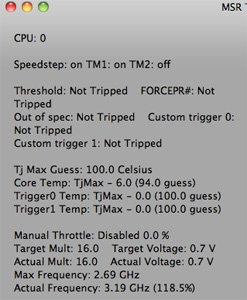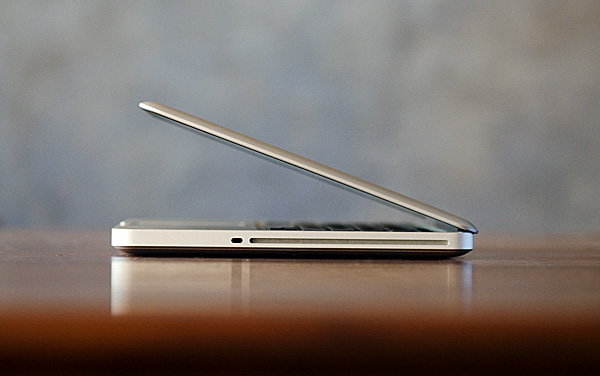The MacBook Pro Review (13 & 15-inch): 2011 Brings Sandy Bridge
by Anand Lal Shimpi, Brian Klug & Vivek Gowri on March 10, 2011 4:17 PM EST- Posted in
- Laptops
- Mac
- Apple
- Intel
- MacBook Pro
- Sandy Bridge
What About The 13?
Apple's new 13-inch MacBook Pro received the biggest upgrade of the lot. Last year Apple opted against moving the 13-inch model to Arrandale and instead gave it a beefy GPU and a mildly evolved Core 2 Duo CPU. The presumed public reasoning was Apple didn't like Arrandale's GPU performance and needed a two chip solution to maintain the platform's size hence the NVIDIA GT 330M + Intel Core 2 Duo setup. Internally I'm wondering if there was a small amount of corporate politics being played there. Apple used to get a discount on Intel CPUs in exchange for exclusivity, that agreement expired with Nehalem. When Nehalem hit, Apple had to pay the same price as everyone else for CPUs. Now does the 2010 Core 2 based 13-inch MacBook Pro make more sense? Keeping Intel's flagship CPU out of Apple's highest volume MacBook Pro had to hurt. I wonder if Apple got discounted pricing on Sandy Bridge as a result...
| Evolution of the 13-inch MacBook Pro | Early 2011 | Mid 2010 | Late 2009 |
| CPU | Intel Core i5 2.3GHz (DC) | Intel Core 2 Duo 2.40GHz (DC) | Intel Core 2 Duo 2.26GHz (DC) |
| Memory | 4GB DDR3-1333 | 4GB DDR3-1066 | 2GB DDR3-1066 |
| HDD | 320GB 5400RPM | 250GB 5400RPM | 160GB 5400RPM |
| Video | Intel HD 3000 (integrated) | NVIDIA GeForce 320M (integrated) | NVIDIA GeForce 9400M (integrated) |
| Optical Drive | 8X Slot Load DL DVD +/-R | 8X Slot Load DL DVD +/-R | 8X Slot Load DL DVD +/-R |
| Screen Resolution | 1280 x 800 | 1280 x 800 | 1280 x 800 |
| USB | 2 | 2 | 2 |
| SD Card Reader | Yes | Yes | Yes |
| FireWire 800 | 1 | 1 | 1 |
| ExpressCard/34 | No | No | No |
| Battery | 63.5Wh | 63.5Wh | 60Wh |
| Dimensions (W x D x H) | 12.78" x 8.94" x 0.95" | 12.78" x 8.94" x 0.95" | 12.78" x 8.94" x 0.95" |
| Weight | 4.5 lbs | 4.5 lbs | 4.5 lbs |
| Price | $1199 | $1199 | $1199 |
While the 15-inch MacBook Pro is quad-core only, the new 13 is strictly dual-core. You get two options: a 2.3GHz or 2.7GHz dual-core Core i5 or Core i7. In Intel speak it's the Core i5-2410M or the Core i7-2620M (it's no wonder Apple doesn't list model numbers for these things).

The 2011 13-inch MacBook Pro Motherboard
| Apple 13-inch 2011 MacBook Pro CPU Comparison | ||||
| 2.3GHz dual-core | 2.7GHz dual-core | |||
| Intel Model | Core i5-2410M | Core i7-2620M | ||
| Base Clock Speed | 2.3GHz | 2.7GHz | ||
| Max SC Turbo | 2.9GHz | 3.4GHz | ||
| Max DC Turbo | 2.6GHz | 3.2GHz | ||
| GPU Base Clock Speed | 650MHz | 650MHz | ||
| GPU Max Turbo | 1.2GHz | 1.3GHz | ||
| L3 Cache | 3MB | 4MB | ||
| AES-NI | No | Yes | ||
| VT-x | Yes | Yes | ||
| VT-d | No | Yes | ||
| TDP | 35W | 35W | ||
The primary differences between these two parts are clock speed, L3 cache size and AES-NI support once again. The 2.3GHz Core i5 lacks AES-NI, has a 3MB L3 cache and can only turbo up to 2.9GHz. The 2.7GHz Core i5 has AES-NI, a 4MB L3 cache and can turbo up as high as 3.4GHz.

I verified turbo frequencies on the 2.7GHz 13-inch. The highest I saw single core turbo hit was 3.4GHz, and dual core turbo was good for 3.2GHz. There's absolutely no funny business going on here, the dual-core 2.7 is allowed to hit its maximum frequencies.

You'll notice that the 2.7GHz DC chip has the same max single core turbo as the 2.3GHz QC chip from the upgraded 15-inch MacBook Pro. In practice this means that for light workloads the upgraded 15 won't feel any faster than the 13 (or that the 13 will feel as fast as the 15 depending on how you look at it). I'm talking about things like web page load times and application launch/install times. There may even be a slight performance advantage for the 13-inch setup as it's able to turbo up to higher frequencies easier than the quad-core 15. Crank up the threads and you've got a different story entirely of course. There's no replacement for more cores on highly threaded workloads.











198 Comments
View All Comments
ImSpartacus - Thursday, March 10, 2011 - link
Apple doesn't do something unless they can do it 100%.They won't default to SSDs until they are on the logic board like the MBA. We'll probably see the disk drive go at the same time.
Maybe Apple will continue to use hard drives for storage? That might be the reason we are still seeing 5400rpm drives. Apple doesn't want to upgrade everyone to 7200rpm drives only to have 5400rpm drives the next year, even only for storage.
But who knows?
Tros - Thursday, March 10, 2011 - link
I imagine they'd go for the MBA-SSD and the larger platter-based storage, and just partition. But to do that smoothly, they need a better partitioning system (to keep it user friendly); ZFS.Nentor - Friday, March 11, 2011 - link
Apple doesn't do something unless they can do it grand (or make it seem grand).Why put in SSD standard if they are still a luxury? As long as the average pc user is not fully aware of what SSD are and what are the great benefits you can still demand premium for them as an upgrade for people that do want one.
Just watch, when SSD are becoming the standard Apple will put put them in and market the hell out of it and make it fit the whole Apple image.
dsumanik - Friday, March 11, 2011 - link
Dude, if your hdd is integrated into your mobo... Not only do have the disadvantage of not being able to upgrade to faster/larger capacity drives...If the disk fails you need to replace the whole board - $$$
If something on the board fails, you lose all your data - facepalm
Apple dictates the price of of the hdd, even when it's a yer old - $$$
A simple, 2 screw user replaceable hdd is the elegant solution and always will be.
Wake up peeps...
They aren't supporting other drives because they want to sell you outdated technology at a higher price.... End of story.
JasperJanssen - Monday, March 14, 2011 - link
Dude, do you even have a vague clue what you are talking about?The MBA doesn't have an SSD soldered onto the mainboard, it has it on a standardised daughter card. And by standardised I don't mean standardised by Apple, although to be fair Apple is the main supplier of machines using it at the moment. It's a card not unlike minipci(e), and entirely swappable from one machine to a replacement. Also, Apple isn't the only one supplying these drives.
It's entirely possible that other thing&light manufacturers will start using them, as it's a very useful form factor.
KoolAidMan1 - Thursday, March 10, 2011 - link
There is no dedicated GPU in the 13" MBP because there isn't room for it. Look at other notebooks in the same size and price class such as the Lenovo x220. Same situation, integrated GPU only. An dedicated GPU means bigger motherboard, which defeats the purpose of notebooks that are so small.Wieland - Thursday, March 10, 2011 - link
Sandy Bridge laptops haven't been on the market very long. It's way too early to make a conclusion about what is and isn't possible in terms of size. That said, the Sony Vaio S is basically the exact same size, lower weight, lower price, and offers almost as much battery life, and it is configurable with two different versions of AMD Radeon Graphics (6470M, 6630M). The new Vaio Z will probably be even more impressive in this regard.ltcommanderdata - Thursday, March 10, 2011 - link
The 13" MacBook Pro is a constant 0.95" thickness. The Vaio S ranges from 1.08" - 1.24" thick, a 14% to 31% difference. So the 13" MacBook Pro has significantly decreased internal volume which will definitely constrain how you lay out internal components and the thermal room on the machine impacting whether it's worthwhile to put in a discrete GPU.claytontullos - Thursday, March 10, 2011 - link
Have you dealt with HP's tech support? It's like pulling teeth to get anything done.My ram in my Dv4 was bad, it would randomly cause windows to crash both in Vista and Windows 7. My ram failed memtest86 with over 4 million errors after a few minutes of testing... however my ram would pass HP's 5 second ram test with flying colors.
HP's support first insisted I revert my laptop back to Vista and in any event would not service my laptop because the ram passed their "test."
I will never buy another HP product.
quiksilvr - Thursday, March 10, 2011 - link
I won't judge a race based on the actions of few. At the same time, I won't judge a company just because one of their products didn't work that well for me. That's like saying I bought a 4 pack of Duracells and one of the batteries weren't working so now I buy Energizer.And to be fair, it isn't like HP made the RAM. If you were getting random crashes, you obviously didn't do anything and are clearly under warranty. Simply say "I turned it on and it keeps crashing" and they'll say "Okay here send it back" and 9/10 they will pay for shipping (depending on where you got it from).
Now I'm not an HP fanboy (far from it, I own a Lenovo), but prior to that I owned a zd8000 for about 5 years with no problems. Does that mean that HP is utterly flawless and no one makes a product like them? No. But I know quality when I see one and I stand by what I said: The Envy 14 is probably one of the best laptops you can get. Hell, it's only $999 and it blows the MBP out of the park.